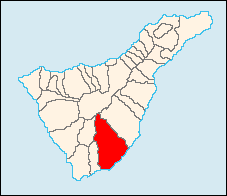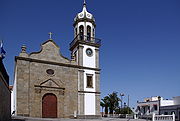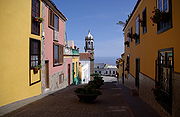
Granadilla de Abona
Encyclopedia
| Granadilla de Abona | |
| Map | |
|---|---|
 |
|
| Statistics | |
| Autonomous region: | Canary Islands Canary Islands The Canary Islands , also known as the Canaries , is a Spanish archipelago located just off the northwest coast of mainland Africa, 100 km west of the border between Morocco and the Western Sahara. The Canaries are a Spanish autonomous community and an outermost region of the European Union... |
| Province: | Santa Cruz de Tenerife Santa Cruz de Tenerife (province) Province of Santa Cruz de Tenerife also Province of Santa Cruz is a province of Spain, consisting of the western part of the autonomous community of the Canary Islands. It consists of about half of the Atlantic archipelago, including the islands of Tenerife, La Gomera, El Hierro, and La Palma, and... |
| Island: | Tenerife Tenerife Tenerife is the largest and most populous island of the seven Canary Islands, it is also the most populated island of Spain, with a land area of 2,034.38 km² and 906,854 inhabitants, 43% of the total population of the Canary Islands. About five million tourists visit Tenerife each year, the... |
| Area Area Area is a quantity that expresses the extent of a two-dimensional surface or shape in the plane. Area can be understood as the amount of material with a given thickness that would be necessary to fashion a model of the shape, or the amount of paint necessary to cover the surface with a single coat... : |
162.43 km² |
| Population Population A population is all the organisms that both belong to the same group or species and live in the same geographical area. The area that is used to define a sexual population is such that inter-breeding is possible between any pair within the area and more probable than cross-breeding with individuals... : |
30,769 (2001) |
| Population density Population density Population density is a measurement of population per unit area or unit volume. It is frequently applied to living organisms, and particularly to humans... : |
189.78/km² |
| Elevation Elevation The elevation of a geographic location is its height above a fixed reference point, most commonly a reference geoid, a mathematical model of the Earth's sea level as an equipotential gravitational surface .... : Lowest: Centre: Highest: |
Atlantic Ocean 500 m Montaña Grande |
| Length of coastline: | about 15 km |
| Postal code: | - |
| Location Location (geography) The terms location and place in geography are used to identify a point or an area on the Earth's surface or elsewhere. The term 'location' generally implies a higher degree of can certainty than "place" which often has an ambiguous boundary relying more on human/social attributes of place identity... : |
28.1667/28°7' N lat. 16.5833/16°35' W long. |
Granadilla de Abona is a municipality
Municipality
A municipality is essentially an urban administrative division having corporate status and usually powers of self-government. It can also be used to mean the governing body of a municipality. A municipality is a general-purpose administrative subdivision, as opposed to a special-purpose district...
of Tenerife
Tenerife
Tenerife is the largest and most populous island of the seven Canary Islands, it is also the most populated island of Spain, with a land area of 2,034.38 km² and 906,854 inhabitants, 43% of the total population of the Canary Islands. About five million tourists visit Tenerife each year, the...
, located in the south of the island, occupying an area of 155 square kilometers. Its population in 1991 was 17,141. In recent years, the population has greatly increased due to an influx of immigrants, many of them illegal, from Western Sahara
Western Sahara
Western Sahara is a disputed territory in North Africa, bordered by Morocco to the north, Algeria to the northeast, Mauritania to the east and south, and the Atlantic Ocean to the west. Its surface area amounts to . It is one of the most sparsely populated territories in the world, mainly...
, Colombia
Colombia
Colombia, officially the Republic of Colombia , is a unitary constitutional republic comprising thirty-two departments. The country is located in northwestern South America, bordered to the east by Venezuela and Brazil; to the south by Ecuador and Peru; to the north by the Caribbean Sea; to the...
, Cuba
Cuba
The Republic of Cuba is an island nation in the Caribbean. The nation of Cuba consists of the main island of Cuba, the Isla de la Juventud, and several archipelagos. Havana is the largest city in Cuba and the country's capital. Santiago de Cuba is the second largest city...
, and other African and Latin American countries.
The municipality extends from the altitudinous center of the island -the mountain of Guajara (2,718 m) is situated in this municipality- to the Atlantic Ocean
Atlantic Ocean
The Atlantic Ocean is the second-largest of the world's oceanic divisions. With a total area of about , it covers approximately 20% of the Earth's surface and about 26% of its water surface area...
. Guajara is the second-highest mountain on the island, after El Teide. The municipality’s landscape, similar to the entire south of the island, is dry and desert-like.
Reina Sofía Airport is located in this municipality, as well as the beachside town of El Médano
El Médano
El Médano is a town in the municipality of Granadilla de Abona, on the island of Tenerife, one of the Canary Islands....
("The Sand Dune"), where many important windsurfing
Windsurfing
Windsurfing or sailboarding is a surface water sport that combines elements of surfing and sailing. It consists of a board usually two to four metres long, powered by the orthogonal effect of the wind on a sail. The rig is connected to the board by a free-rotating universal joint and comprises a...
competitions are held. La Montaña Roja ("The Red Mountain"), a volcanic cone located in El Médano, is a protected natural preserve, along with five other “espacios naturales,” which comprise 25% of the municipality’s total area. Plans to build an industrial and commercial port in this municipality along a 5 kilometres (3.1 mi) sector along the coast, from Barranco del Río to Montaña Pelada, have been discussed but not implemented, due to concerns about the environmental damage such a development would cause.
There is a wind farm
Wind farm
A wind farm is a group of wind turbines in the same location used to produce electric power. A large wind farm may consist of several hundred individual wind turbines, and cover an extended area of hundreds of square miles, but the land between the turbines may be used for agricultural or other...
(parque eólico) in this municipality as well.
Communities
The municipality's main town is Granadilla de Abona; other towns include San Isidro, El Cabezo, Castro, Los AbrigosLos Abrigos
Los Abrigos is a small fishing village in Granadilla de Abona, Tenerife. It has a small harbour, which developers want to expand.-References:...
, Charco del Pino, Montaña de Yaco, El Salto, and Los Llanos.
Historical population
| Year | Population | Change | Density |
|---|---|---|---|
| 1991 | 16,884 | - | - |
| 1996 | 18,508 | - | - |
| 2001 | 21,135 | - | 130.46/km² |
| 2002 | 27,224 | - | - |
| 2003 | 28,927 | - | 178.09/km² |
| 2004 | 30,769 | - | 189.78/km² |
History


Guanches
Guanches is the name given to the aboriginal Berber inhabitants of the Canary Islands. It is believed that they migrated to the archipelago sometime between 1000 BCE and 100 BCE or perhaps earlier...
menceyato, or kingdom, that existed in this region of the island at the time of Spanish conquest in the late fifteenth century. Founded around 1445, Abona was ruled by Atguaxoña, son of Axerax and whose son after the conquest was baptised and named Alonso Gonzalez. It extended from the Río de Chasna to Adeje, from the Barranco de Herques, to Güimar
Güímar
Güímar is the name of a municipality, town, and valley in the eastern part of the Spanish island of Tenerife, one of the Canary Islands, and part of Santa Cruz de Tenerife...
. The Spanish toponym
Toponymy
Toponymy is the scientific study of place names , their origins, meanings, use and typology. The word "toponymy" is derived from the Greek words tópos and ónoma . Toponymy is itself a branch of onomastics, the study of names of all kinds...
of Granadilla does not appear until the end of the sixteenth century, but the settlement of the area by Europeans began at the time of conquest.
The Bay of El Médano was the last stop for provisions for Ferdinand Magellan
Ferdinand Magellan
Ferdinand Magellan was a Portuguese explorer. He was born in Sabrosa, in northern Portugal, and served King Charles I of Spain in search of a westward route to the "Spice Islands" ....
and Juan Sebastián Elcano
Juan Sebastián Elcano
Juan Sebastián Elcano was a Basque Spanish explorer who completed the first circumnavigation of the world. As Ferdinand Magellan's second in command, Elcano took over after Magellan's death in the Philippines.-Early life:Elcano was born to Domingo Sebastián Elcano I and Catalina del Puerto...
during the circumnavigation of the world. The expedition's cartographer and translator, Antonio Pigafetta
Antonio Pigafetta
Antonio Pigafetta was an Italian scholar and explorer from the Republic of Venice. He travelled with the Portuguese explorer Ferdinand Magellan and his crew on their voyage to the Indies. During the expedition, he served as Magellan's assistant and kept an accurate journal which later assisted him...
, left this description of the place: "On Tuesday, September 20, in the same year [1519] we departed from the place called Sanlúcar [de Barrameda], heading southwest, and before the end of the month, on the 26th, we arrived at an island that is called Tenerife, at 28 degrees longitude, to acquire meat, water, and firewood. We remained there for three days and a half; later we approached another port on the same island, Monte Rosso [Montaña Roja] by name, lingering there for two days…On Monday, October 3, at midnight, we departed southwards..."http://www.liberliber.it/biblioteca/p/pigafetta/relazione_del_primo_viaggio_intorno_al_mondo/relazion.zip
Records indicate that a church existed in the municipality in 1575. A Franciscan
Franciscan
Most Franciscans are members of Roman Catholic religious orders founded by Saint Francis of Assisi. Besides Roman Catholic communities, there are also Old Catholic, Anglican, Lutheran, ecumenical and Non-denominational Franciscan communities....
convent was founded in February 1665. St. Peter of Saint Joseph Betancur
Hermano Pedro de San José de Betancurt
Brother Peter of Saint Joseph Betancur Brother Peter of Saint Joseph Betancur Brother Peter of Saint Joseph Betancur (March 21, 1626 (Tenerife)—April 25, 1667 (Antigua Guatemala), called Hermano Pedro de San José Betancurt or more simply Hermano Pedro, Santo Hermano Pedro, or San Pedro de Vilaflor,...
(1626-1667), spent some time in a little cave
Cave
A cave or cavern is a natural underground space large enough for a human to enter. The term applies to natural cavities some part of which is in total darkness. The word cave also includes smaller spaces like rock shelters, sea caves, and grottos.Speleology is the science of exploration and study...
situated near the present-day town of El Médano. The cave is now the site of a small shrine dedicated to the saint.
Granadilla de Abona acquired the status of a municipality in the nineteenth century, and a highway linking it to other parts of the island in the 1930s. Previously, travel to other parts of the island was only possibly by boat, which departed from the seaside towns of El Médano and Los Abrigos.

Other
Granadilla de Abona has schools, a concert hall, a gymnasium, banks, churches, a beaches and a few squares (plazaPlaza
Plaza is a Spanish word related to "field" which describes an open urban public space, such as a city square. All through Spanish America, the plaza mayor of each center of administration held three closely related institutions: the cathedral, the cabildo or administrative center, which might be...
s).
External links
- Official Website
- GRANADILLA DE ABONA: Al abrigo de los Volcanes
- Abona: La Ultima Resistencia Guanche a la Esclavitud (in Spanish; history of Guanche menceyato)

